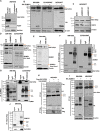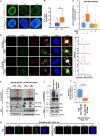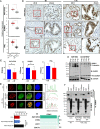SUMO Modification of PAF1/PD2 Enables PML Interaction and Promotes Radiation Resistance in Pancreatic Ductal Adenocarcinoma
- PMID: 34570619
- PMCID: PMC8608017
- DOI: 10.1128/MCB.00135-21
SUMO Modification of PAF1/PD2 Enables PML Interaction and Promotes Radiation Resistance in Pancreatic Ductal Adenocarcinoma
Abstract
RNA polymerase II-associated factor 1 (PAF1)/pancreatic differentiation 2 (PD2) is a core subunit of the human PAF1 complex (PAF1C) that regulates the RNA polymerase II function during transcriptional elongation. PAF1/PD2 has also been linked to the oncogenesis of pancreatic ductal adenocarcinoma (PDAC). Here, we report that PAF1/PD2 undergoes posttranslational modification (PTM) through SUMOylation, enhancing the radiation resistance of PDAC cells. We identified that PAF1/PD2 is preferentially modified by small ubiquitin-related modifier 1 (SUMO 1), and mutating the residues (K)-150 and 154 by site-directed mutagenesis reduces the SUMOylation. Interestingly, PAF1/PD2 was found to directly interact with the promyelocytic leukemia (PML) protein in response to radiation, and inhibition of PAF1/PD2 SUMOylation at K-150/154 affects its interaction with PML. Our results demonstrate that SUMOylation of PAF1/PD2 increased in the radiated pancreatic cancer cells. Furthermore, inhibition of SUMOylation or PML reduces the cell growth and proliferation of PDAC cells after radiation treatment. These results suggest that SUMOylation of PAF1/PD2 interacts with PTM for PDAC cell survival. Furthermore, abolishing the SUMOylation in PDAC cells enhances the effectiveness of radiotherapy. Overall, our results demonstrate a novel PTM and PAF1/PD2 interaction through SUMOylation, and inhibiting the SUMOylation of PAF1/PD2 enhance the therapeutic efficacy for PDAC.
Keywords: PAF1; SUMO1; pancreatic cancer; polymorphonuclear leukocytes; radiation resistance; sumoylation.
Figures






Similar articles
-
PD2/Paf1 depletion in pancreatic acinar cells promotes acinar-to-ductal metaplasia.Oncotarget. 2014 Jun 30;5(12):4480-91. doi: 10.18632/oncotarget.2041. Oncotarget. 2014. PMID: 24947474 Free PMC article.
-
PAF1 cooperates with YAP1 in metaplastic ducts to promote pancreatic cancer.Cell Death Dis. 2022 Oct 1;13(10):839. doi: 10.1038/s41419-022-05258-x. Cell Death Dis. 2022. PMID: 36180487 Free PMC article.
-
Overexpression of PD2 leads to increased tumorigenicity and metastasis in pancreatic ductal adenocarcinoma.Oncotarget. 2016 Jan 19;7(3):3317-31. doi: 10.18632/oncotarget.6580. Oncotarget. 2016. PMID: 26689992 Free PMC article.
-
PD2/PAF1 at the Crossroads of the Cancer Network.Cancer Res. 2018 Jan 15;78(2):313-319. doi: 10.1158/0008-5472.CAN-17-2175. Epub 2018 Jan 8. Cancer Res. 2018. PMID: 29311159 Free PMC article. Review.
-
The SUMO pathway in pancreatic cancer: insights and inhibition.Br J Cancer. 2021 Feb;124(3):531-538. doi: 10.1038/s41416-020-01119-6. Epub 2020 Oct 19. Br J Cancer. 2021. PMID: 33071285 Free PMC article. Review.
Cited by
-
Knockdown of PAF1 reduces cervical cancer cell proliferation, migration and invasion via retarding FLOT2-mediated MEK/ERK1/2 pathway.Cell Adh Migr. 2023 Dec;17(1):1-10. doi: 10.1080/19336918.2023.2260641. Epub 2023 Sep 27. Cell Adh Migr. 2023. PMID: 37754347 Free PMC article.
-
On the Prevalence and Roles of Proteins Undergoing Liquid-Liquid Phase Separation in the Biogenesis of PML-Bodies.Biomolecules. 2023 Dec 18;13(12):1805. doi: 10.3390/biom13121805. Biomolecules. 2023. PMID: 38136675 Free PMC article.
-
SUMO-Activating Enzyme Subunit 1 Is Associated with Poor Prognosis, Tumor Progression, and Radio-Resistance in Colorectal Cancer.Curr Issues Mol Biol. 2023 Sep 30;45(10):8013-8026. doi: 10.3390/cimb45100506. Curr Issues Mol Biol. 2023. PMID: 37886949 Free PMC article.
-
Unveiling the resistance to therapies in pancreatic ductal adenocarcinoma.Drug Resist Updat. 2024 Nov;77:101146. doi: 10.1016/j.drup.2024.101146. Epub 2024 Aug 30. Drug Resist Updat. 2024. PMID: 39243602 Review.
-
Targeting protein modification: a new direction for immunotherapy of pancreatic cancer.Int J Biol Sci. 2025 Jan 1;21(1):63-74. doi: 10.7150/ijbs.101861. eCollection 2025. Int J Biol Sci. 2025. PMID: 39744438 Free PMC article. Review.
References
-
- Barhoumi M, Mornex F, Bonnetain F, Rougier P, Mariette C, Bouché O, Bosset JF, Aparicio T, Mineur L, Azzedine A, Hammel P, Butel J, Stremsdoerfer N, Maingon P, Bedenne L, Chauffert B. 2011. Locally advanced unresectable pancreatic cancer: induction chemoradiotherapy followed by maintenance gemcitabine versus gemcitabine alone: definitive results of the 2000–2001 FFCD/SFRO phase III trial. Cancer Radiother 15:182–191. 10.1016/j.canrad.2010.10.001. - DOI - PubMed
Publication types
MeSH terms
Substances
Grants and funding
LinkOut - more resources
Full Text Sources
Medical
Molecular Biology Databases
Research Materials
